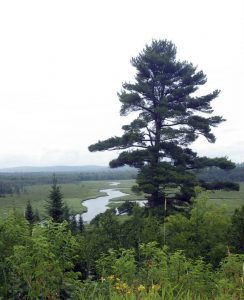
I suspect that virtually every Nova Scotian who has visited Maine (and that’s most of us) knows exactly where this photo was taken. There’s a lot of carbon sequestration going on here.
If promoting wood for construction puts a higher premium on older trees/shade tolerant species, it could also help to reinvigorate the Acadian forest, thereby benefitting native biodiversity and ecosystem services. We could have our cake and eat it too. We don’t when our forestry is focussed on “low value wood” (early successional species harvested on short rotations) for pulp and paper, bioenergy, bioplastics and the like.
Mitch Lansky, who I would describe as a Maine elder and is well known to readers of Rural Delivery, explores these topics in depth in relation to the forest industry in Maine in The Double Bottom Line: Managing Maine’s Forests to Increase Carbon Sequestration and Decrease Carbon (April 2016).
Download Full text (36 pages docx) | View Summary
From Lansky’s conclusions:
“If we are serious about making a positive difference in addressing global climate change, we have the challenge of meeting two bottom lines: increasing carbon sequestration and decreasing carbon emissions. The goal of increased carbon sequestration is measured by increases in the standing volume of live and dead trees, increases of average tree size, increases of average growth per acre per year, increases in soil organic matter, and increases in the diversity of tree allies, such as mycorrhizal fungi. Calling millions of acres “sustainable,” if these metrics are not even criteria for that definition, is not the solution.
“The goal of reduced carbon emissions is measured by reduced emissions from burning of any carbon-based fuels, including biomass. This can be achieved through increased efficiencies in production, distribution, and use, and switching to lower carbon-emitting power sources. Calling biomass “carbon neutral” and then ignoring biomass carbon emissions is not the solution. Time matters. We need to progress toward these double goals now. Decreasing carbon sequestration and increasing carbon emissions now, with the promise of improvements decades from now, is not the solution.“We are using technologies in the Maine woods that make carbon sequestration management difficult. We have markets for wood products that are heavy carbon emitters. We need to transition toward lower emission alternatives that will create a higher percentage of wood products that continue to sequester carbon. We need to meet the bottom-line goals and create employment opportunities. Subsidizing use of high-carbon-emitting technologies or markets that have low added value in the name of protecting jobs is not the solution. Feedback to society from changes in forest practices and carbon emissions is delayed by decades. We are now responding to the consequences of actions of previous generations. What we do now will have consequences to future generations. We need to manage more for forest diversity and stability, as well as for quality, keeping options open for future generations. Managing forests for the future based on current low-grade markets is not the solution, especially when that management leads to simplifying forest stands and reducing future options. Trend is not destiny. Markets change.”
Surely those words apply equally to Nova Scotia.

